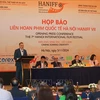 The manufacturing and processing industry had the highest labour number at 1.2 million workers suffering negative impacts due to the pandemic. (Photo daibieunhandan.vn)
The manufacturing and processing industry had the highest labour number at 1.2 million workers suffering negative impacts due to the pandemic. (Photo daibieunhandan.vn) Hanoi (VNS/VNA) - The COVID-19 pandemic has hit Vietnam from the end of January, directly impacting the domestic labour market, according to the General Statistics Office (GSO)'s report on labour and jobs in the first quarter of this year.
Unemployment also reached the highest rate over the last five years, said Vu Thi Thu Thuy, head of the GSO’s Department of Population and Labour Statistics.
In the first quarter, the number of unemployed people out of the working-age population was nearly 1.1 million, up by 26,000 people from the previous quarter and up 26,800 people year on year.
At the same time, the income growth rate of labour year on year was nearly a half of the growth rate in the first quarter of last year compared to the first quarter of 2018.
In the context of the COVID-19 pandemic, labourers without work contracts and unofficial employment are the most vulnerable, Thuy said.
According to the GSO survey on impacts of COVID-19 to businesses and employment in the first four months, there were nearly five million workers suffering negative impacts from the pandemic.
Of which, the manufacturing and processing industry was the most affected with 1.2 million workers; following by the wholesale and retail industry with more than 1.1 million workers and the accommodation and catering industry with nearly 740,000 workers.
As of mid-April 2020, the transport, warehousing and education sectors had the highest number of temporarily laid-off workers, accounting for 70 percent of the total workers in each sector.
Meanwhile, the manufacturing and processing industry and the catering service industry had the highest proportion of permanently unemployed and laid-off workers accounting for nearly 20 percent of the total workers in each sector.
According to the office, large and medium-sized enterprises were more vulnerable than small and micro enterprises with more than 90 percent of large and medium-sized enterprises having difficulties in the first four months of this year.
Challenges remains
“Until the end of the second quarter, the pandemic will remain a significant challenge for enterprises and workers. Therefore, to overcome present difficulties, the Government, businesses and workers need to work together to control the pandemic and to gradually stabilise and develop the domestic economy,” GSO Deputy General Director Pham Quang Vinh said.
The Government has put forward many policies to prevent and control the pandemic as well as support enterprises and employees to overcome those difficulties and ensure social security.
However, to increase efficiency of these policies, ministries, sectors and localities need coordination in administrative reform to ensure that all eligible enterprises and workers could enjoy the Government’s support packages due to difficulties during the pandemic.
Besides that, those businesses and workers need to be aware that those policies are only supportive, so they need to actively find business and employment opportunities during and after the pandemic.
Thuy has recommended that the enterprises should renew production and business processes as well as find new import markets of input materials and expand export markets.
They should also have training courses to improve skills of workers and promote application of information technology to convert from traditional to online transactions.
For workers, they need to improve their professional skills and prepare soft skills to adapt to non-stop changes of the labour market, Thuy said./.
VNA
























